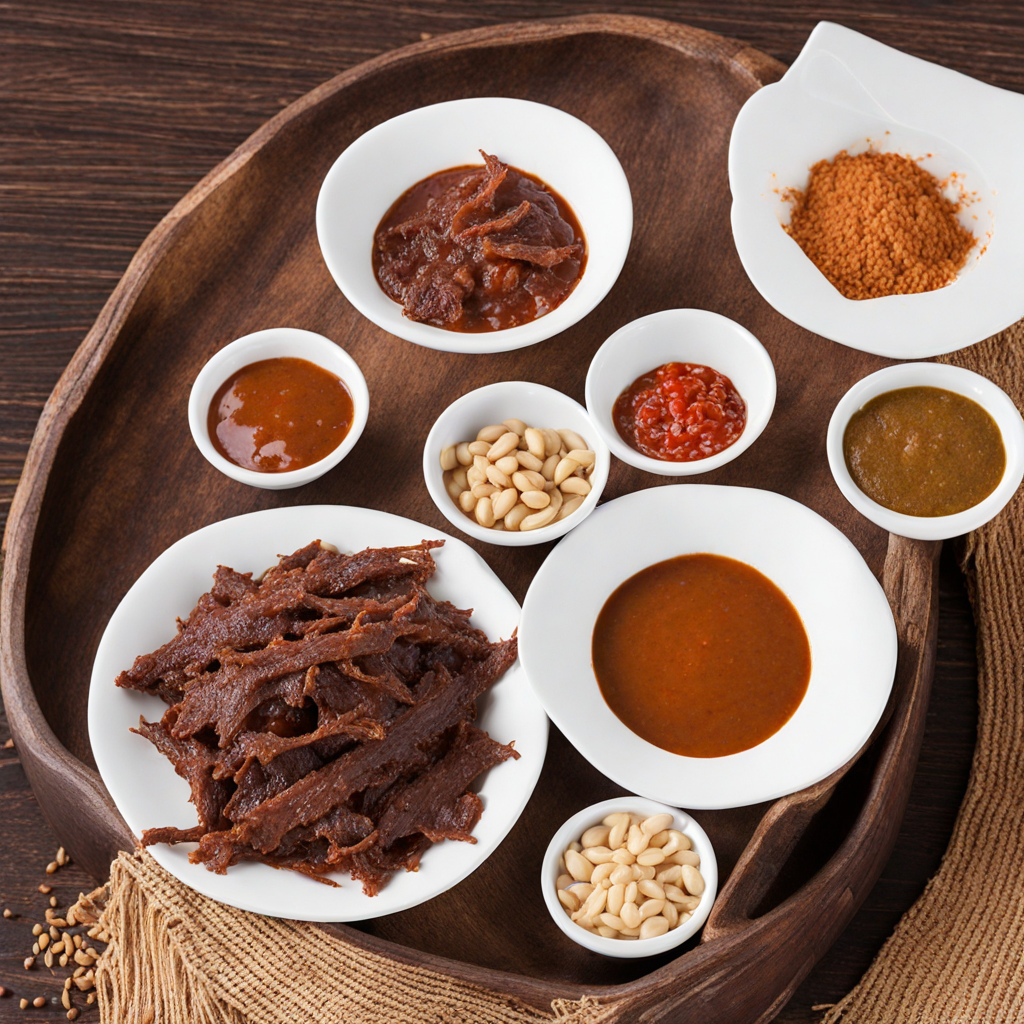Zamblé
Zamblé is a vibrant and flavorful dish from Mali that captures the essence of West African cuisine. This traditional meal typically features a hearty base of rice or millet, which serves as the perfect canvas for an array of ingredients. The dish is often enriched with a colorful medley of vegetables, such as carrots, bell peppers, and okra, which not only add visual appeal but also infuse the dish with essential nutrients and a variety of textures. The vegetables are usually sautéed with aromatic spices, including garlic, ginger, and a blend of local seasonings that create a warm, inviting aroma that fills the air. The star of Zamblé is its protein component, which can vary from chicken, beef, or fish, depending on regional preferences and availability. The meat is tenderized through slow cooking, allowing it to soak up the flavors of the spices and vegetables. A unique aspect of Zamblé is the addition of groundnut (peanut) paste, which brings a rich, creamy texture and a nutty depth that balances the dish beautifully. This ingredient is a staple in Malian cooking and enhances Zamblé's overall flavor profile, making each bite a delightful experience. As you savor Zamblé, you will also encounter the depth of flavor that comes from the careful layering of spices and the slow cooking process. The dish is often served communally, inviting diners to share in the experience and enjoy the comforting, hearty meal together. With its rich combination of ingredients and flavors, Zamblé is not just a meal; it’s a celebration of Mali’s culinary heritage, making it a must-try for anyone looking to explore new and exciting tastes.
How It Became This Dish
The History of Zamblé: Mali's Culinary Heritage #### Origins of Zamblé Zamblé, a cherished dish from Mali, is a testament to the rich tapestry of West African culinary traditions. This dish, primarily made from millet or sorghum, is often accompanied by various sauces and vegetables, reflecting the agricultural bounty of the region and the ingenuity of its people. The origins of Zamblé can be traced back to the ancient civilizations that flourished in the Sahel and Sudanian regions, where millet and sorghum have been staple crops for millennia. These grains are not only resilient to the harsh climatic conditions of the area but also versatile, allowing for a myriad of dishes to be created. Traditionally, Zamblé is prepared during communal gatherings, celebrations, and rites of passage, emphasizing its role as a food that brings people together. The preparation of Zamblé is often a communal affair, involving families and friends who come together to grind the grains, cook the dish, and share stories, laughter, and wisdom. This practice underscores the dish's importance as a symbol of community and solidarity. #### Cultural Significance In Mali, food is deeply intertwined with culture, identity, and social structure. Zamblé holds a special place in the hearts of Malians, as it embodies the spirit of hospitality and generosity. When guests arrive, serving Zamblé is a way to honor them, reflecting the Malian ethos of sharing and community. The dish is often accompanied by a variety of sauces made from peanuts, tomatoes, and local greens, which enrich the flavors and provide nutritional balance. Moreover, Zamblé is not merely sustenance; it is a narrative thread that weaves through the rich history of the Malian people. The dish is often served during significant cultural events, such as weddings and festivals, symbolizing prosperity and abundance. The act of sharing Zamblé during these occasions underscores the importance of kinship and community ties, reinforcing social bonds and cultural continuity. #### Development Over Time The evolution of Zamblé can be seen as a reflection of Mali's broader historical and social changes. As trade routes expanded during the medieval period, particularly with the rise of the Mali Empire (c. 1235-1600), the exchange of ingredients and culinary techniques flourished. The introduction of new spices, vegetables, and cooking methods influenced how Zamblé was prepared and consumed. During the colonial period, Mali underwent significant transformations that affected its agricultural practices and food culture. The imposition of colonial agricultural policies shifted local food production towards cash crops, impacting the availability of traditional grains like millet and sorghum. In response, Malian communities adapted by innovating their recipes and using available resources. This resilience is evident in the continued popularity of Zamblé, which has remained a staple food despite the challenges posed by external influences. In contemporary times, Zamblé has seen a resurgence of interest, particularly as Malians and their diaspora seek to reconnect with their culinary heritage. The global movement towards sustainable and local eating has further elevated the profile of traditional dishes like Zamblé. Chefs and food enthusiasts are exploring and celebrating the dish, creating new interpretations while honoring its roots. This revival is not only about preserving cultural identity but also about promoting local agriculture and sustainable food practices. #### Ingredients and Preparation Zamblé is primarily made from millet or sorghum, both of which are integral to Malian agriculture. The preparation begins with the grains being soaked, ground, and then kneaded into a dough. The dough is typically formed into small balls or discs before being steamed in a traditional pot known as a “daba.” The steaming process ensures that the Zamblé is fluffy and light, making it an ideal accompaniment to a variety of rich sauces. The sauces served with Zamblé are as diverse as the regions of Mali itself. Common ingredients include groundnuts, tomatoes, okra, and leafy greens, all of which are abundant in the country. The choice of sauce often reflects personal preferences and regional specialties, further highlighting the dish's adaptability. For instance, in some areas, Zamblé may be served with a spicy peanut sauce, while in others, a tomato-based sauce with vegetables might take precedence. #### Modern Interpretations and Global Influence As Mali’s culinary landscape continues to evolve, Zamblé is increasingly featured in restaurants and culinary festivals outside of Mali. Chefs around the world are drawing inspiration from traditional Malian dishes, showcasing Zamblé in fusion cuisine that highlights its flavors and textures. This global interest not only promotes Malian food culture but also helps to raise awareness of the agricultural practices and challenges faced by Mali’s farmers. Moreover, the resurgence of interest in traditional foods has encouraged younger generations to take pride in their culinary heritage. Cooking classes and food festivals celebrating Zamblé and other traditional dishes are becoming more common, fostering a sense of community and enthusiasm for local cuisine. Social media platforms have also played a crucial role in this revival, with food bloggers and influencers sharing recipes, cooking tips, and the stories behind Zamblé, further broadening its reach. #### Conclusion Zamblé is more than just a dish; it is a cultural symbol that embodies the resilience, creativity, and communal spirit of the Malian people. Its origins reflect the agricultural practices of ancient civilizations, while its modern interpretations illustrate the adaptability of culinary traditions in the face of change. As Zamblé continues to evolve and gain recognition on the global stage, it serves as a reminder of the importance of food in shaping cultural identity and fostering community ties. In every bite of Zamblé, one can taste the history, the struggles, and the triumphs of a people whose culinary heritage remains vibrant and essential to their identity.
You may like
Discover local flavors from Mali







